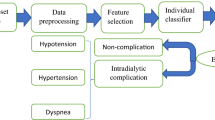Abstract
The main goal of our research was attempt to answer the question, if machine learning algorithms could be applied in computer aided medical diagnostics. Executed tests proven, that data mining methods based on machine learning can be used in medical diagnostics, but it can not substitute an expert, especially in case of rare diseases.
Classifiers induced from revised datasets have better classification accuracy. It is indicating that quality of training data has significant influence for induced classifier accuracy.
In expert opinion of expert, the most of obtained decision rules are consistent with medical knowledge. All cases of incorrect classification were caused by insufficient mathematical model. The evaluation of exact mathematical model in medicine is very difficult.
In this paper results of experiments on two popular machine learning algorithms were presented. The appliance of other classification methods, like Bayesian classifiers, neural networks and fuzzy sets, is subject of future research.
Access this chapter
Tax calculation will be finalised at checkout
Purchases are for personal use only
Preview
Unable to display preview. Download preview PDF.
Similar content being viewed by others
References
Januszewicz Wlodzimierz, Kokot F. (red.), Internal Medicine, Medical Publishers PZWL, Warsaw 2002 (in polish)
Mitchell Tom, Machine Learning, McGraw Hill, 1997
Orlowski Tadeusz (red.), Kidney Diseases, Medical Publishers PZWL, Warsaw 1997 (in polish)
Quinlan J. Ross, C4.5: Programs For Machine Learning, Morgan Kaufmann Publishers, San Mateo, California, 1993
Rutkowski Boleslaw, Czekalski S., Guidelines for Kidney Diseases Diagnosis and Treatment, Medical Publishers Makmed, Gdansk 2001 (in polish)
Witten Ian H., Eibe F., Data Mining: Practical Machine Learning Tools and Techniques with Java Implementations, Morgan Kaufmann Publishers, 2000
Clark Peter, Niblett Tim, The CN2 Induction Algorithm, Machine Learning Journal, 3(4), pp261–283, 1989
Clark Peter, Boswell R., Rule Induction Witch CN2: Some Recent Improvements, Machine Learning-Proceedings of the Fifth European Conference (EWSL-31), pp151–163, 1991
Author information
Authors and Affiliations
Editor information
Editors and Affiliations
Rights and permissions
Copyright information
© 2005 Springer-Verlag Berlin Heidelberg
About this paper
Cite this paper
Penar, W., Wozniak, M. (2005). Machine Learning Methods for Dialysis Therapy Decision Problem — Comparative Study. In: Kurzyński, M., Puchała, E., Woźniak, M., żołnierek, A. (eds) Computer Recognition Systems. Advances in Soft Computing, vol 30. Springer, Berlin, Heidelberg. https://doi.org/10.1007/3-540-32390-2_77
Download citation
DOI: https://doi.org/10.1007/3-540-32390-2_77
Publisher Name: Springer, Berlin, Heidelberg
Print ISBN: 978-3-540-25054-8
Online ISBN: 978-3-540-32390-7
eBook Packages: EngineeringEngineering (R0)




